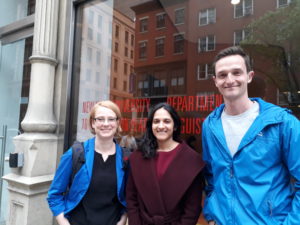 We were fortunate enough to have spent a week in late April visiting Dr. Sudha Arunachalam at the Language Experience and Acquisition Research (LEARN) Lab at New York University. Having had a day to acclimatise to the pace of New York City, we started our visit by presenting our recent work at the monthly lab meeting on the kinds of adjectives preschoolers hear in child-directed speech. In this study we found adjectives occurred more frequently in prenominal positions (e.g. the red car) than postnominal positions (e.g. the car that’s red), though postnominal frames were more frequent for less familiar adjectives – we think this helps children when learning adjectives. Additionally, adjectives occurred much more frequently with a descriptive function i.e. describing things in their own right (e.g. the handsome prince), compared to contrastive adjectives, i.e. those which make comparisons (e.g. the big one), especially for less familiar adjectives. These findings present a puzzle: the types of adjectives that children hear are not those that studies have shown to be most beneficial for learning.
We were fortunate enough to have spent a week in late April visiting Dr. Sudha Arunachalam at the Language Experience and Acquisition Research (LEARN) Lab at New York University. Having had a day to acclimatise to the pace of New York City, we started our visit by presenting our recent work at the monthly lab meeting on the kinds of adjectives preschoolers hear in child-directed speech. In this study we found adjectives occurred more frequently in prenominal positions (e.g. the red car) than postnominal positions (e.g. the car that’s red), though postnominal frames were more frequent for less familiar adjectives – we think this helps children when learning adjectives. Additionally, adjectives occurred much more frequently with a descriptive function i.e. describing things in their own right (e.g. the handsome prince), compared to contrastive adjectives, i.e. those which make comparisons (e.g. the big one), especially for less familiar adjectives. These findings present a puzzle: the types of adjectives that children hear are not those that studies have shown to be most beneficial for learning.
To solve this puzzle, we talked to colleagues at the LEARN lab about the design and method for a brand new study. Although adjectives are a common part of language, they can be difficult for children to learn. Research shows that adults use information about the world to interpret adjectives quickly during listening. For example, when hearing “Where’s the big cow?”, adults can use the word big in its visual context to work out that the speaker is referring to the cow, even before they’ve heard the word cow! But we don’t yet know whether children’s understanding works in the same way. The aim of the study is therefore to understand how 3- to 4-year-old children comprehend different types of scalar adjectives like big and little. In this experiment, children will sit in front of a computer monitor and piece of equipment called an eyetracker. Children will see a series of pictures appear on the screen. Instructions which contain prenominal and postnominal adjectives encourage kids to point to particular pictures. The eyetracker records where children look on the screen and for how long they continue to look. The data will tell us how children come to make sense of descriptive language, and how their understanding might differ from adults. We had some very fruitful discussions with lab members and it was really interesting to share our experiences in designing and running eyetracking studies.
Another aim of the visit was to expand our understanding of how to analyse eyetracking data. Back in Leeds, we have collected data from a group of adults, using the method above. Having completed data collection, the next step is to analyse the data. But before we can do that, we need to spend some time preparing the data for analysis. Eyetrackers typically output a lot of data – as much as 1000 datapoints a second! That’s about 400,000 rows in an Excel spreadsheet, for each of our 40 participants. And so we need to narrow down the specific time regions or ‘interest periods’ prior to running our analysis. Therefore, with the help of Sudha and Prof. Irina Sekerina we spend lots of time crunching our data!
On the final day of our visit, we were also able to find out more about a new ‘naturalistic eyetracking’ experiment that is being developed by researchers at the LEARN lab. This approach is being used to study children’s real-time language processing of their parents’ unscripted speech. Focusing on the phrases that parents use to label particular objects, children and caregivers play a game in which parents name one of several objects displayed on a screen, and the child has to identify it as their eye gaze is tracked. We are hoping to use this paradigm back in Leeds to investigate how children use the specific input from their caregivers to comprehend descriptive language.
It was a fantastic experience to be able to visit a different lab (not least in New York City!) Our week at the LEARN lab really broadened our own understanding of designing, running, and analysing experimental studies. In the future we hope to collaborate with some of the fantastic researchers we had the pleasure of working with. Over the next few weeks in Leeds we will be running more analyses on the data we’ve collected with adults, before turning our focus to launching our study with 3- and 4-year-olds. Watch this space!

